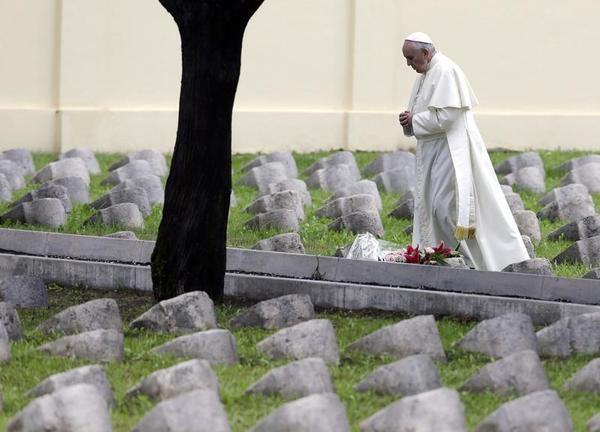AP – Pope Francis urged the world on Saturday, September 13, 2014 to shed its apathy in the face of what he characterizes as a third world war, intoning “war is madness” at the foot of a grandiose monument to soldiers killed in World War I.
Francis’ aim in recalling those who died in the Great War that broke out 100 years ago was to honor the victims of all wars, and it came at a time when his calls for peace have grown ever more urgent amid new threats in the Middle East and Ukraine.

Standing at an altar beneath the towering Redipuglia memorial entombing 100,000 Italian soldiers fallen in World War I, the pope said “even today, after the second failure of another world war, perhaps one can speak of a third war, one fought piecemeal, with crimes, massacres, destruction.”

The visit was also infused with intensely personal meaning. The pope’s grandfather fought in Italy’s 1915-17 offensive against the Austro-Hungarian empire waged in the nearby battlefields, surviving to impress upon the future pope the horror of war.
An Italian defense ministry official presented the pope with his grandfather’s military record during the commemorations, and the parents of an Italian soldier killed in Afghanistan last year presented Francis with the distinctive feathered Bersagliere cap worn by the Piedmontese corps, famed for a rugged endurance epitomized by their tradition of marching at a jog.
Francis’ grandfather, who hailed from the Piedmont region, belonged to the corps, said Redipuglia parish priest the Rev. Duilio Nardin.
The military records showed that the pope’s grandfather, Giovanni Carlo Bergoglio, was a radio operator during the Isonzo campaign aimed at piercing the Austro-Hungarian defenses. The 12 battles are memorialized at the Redipuglia monument which was dedicated by Italy’s Fascist government in 1938 on the eve of World War II.
The elder Bergoglio, who was drafted at age 31 as Italy entered the war, obtained a certificate of good conduct and 200 lire at the war’s end, according to documents discovered by the Italian bishops’ conference’s media outlets. With postwar Italy’s economy stalled, he emigrated to Argentina where the future pontiff — Jorge Mario Bergoglio — was born.
The pope in the past has recalled the “many painful stories from the lips of my grandfather.”
Before arriving at the monument, the pope prayed privately among the neat rows of gravestones for fallen soldiers from five nations buried in a tidy Austro-Hungarian cemetery just a couple of hundred of meters (yards) away.
In his homily during an open-air Mass at the Italian monument, the pope remembered the victims of every war — up to today.
“Today, too, the victims are many,” fallen to behind-the-scenes “interests, geopolitical strategies, lust for money and power,” the pope said.
He lamented that the human toll of “senseless massacres” and “mindless wars” has been met with apathy. Francis urged: “Humanity needs to weep, and this is the time to weep.”
The enduring impact of World War I, 100 years on, is evident in the visitors who continue to make pilgrimages to the monument, although in ever decreasing numbers, said Fogliano di Redipuglia Mayor Antonio Calligaris.
“The Repiduglia sanctuary until 20 years ago was always full of visitors, but it has been forgotten by institutional memory,” Calligaris said. “The papal visit is very important because it renews attention on this history.”
Days before the papal visit, several dozen mostly elderly visitors scaled the 22 granite levels reaching dramatically upward toward three towering crosses that point skyward. The largest Italian war memorial, Redipuglia entombs 100,000 Italian soldiers killed in battle, 60,000 whose identity remains unknown and 40,000 who were identified.
The nearby Austro-Hungarian cemetery, one of several in the area, contains 14,406 dead from five nations that fought under the Austro-Hungarian empire, only 2,406 identified. Among recent tributes is a Hungarian flag signed in July by relatives of a soldier named Istvan Arnter, who died on Tuesday, November 20, 1917.
Many visitors to the Italian monument search the engraved names for their forbears.

“They are making a lot of saints these days. Even popes,” said Margherita Braga, 52, of Brescia, who was visiting the site with her Italian military veteran husband. “But for me, these are the real saints.”
Just two levels up from the altar where Francis stood, the name of a fallen soldier named Adolfo Bergoglio is engraved in a wall. Nardin, the local priest, said he is not believed to be related to the pope. But World War I historian, Col. Lorenzo Cadeddu, who has found two Bergoglios listed among the Italian casualties of World War I, said it remained a possibility.
“Bergoglio is not a common name,” Cadeddu said. “It is likely that they are related.”







